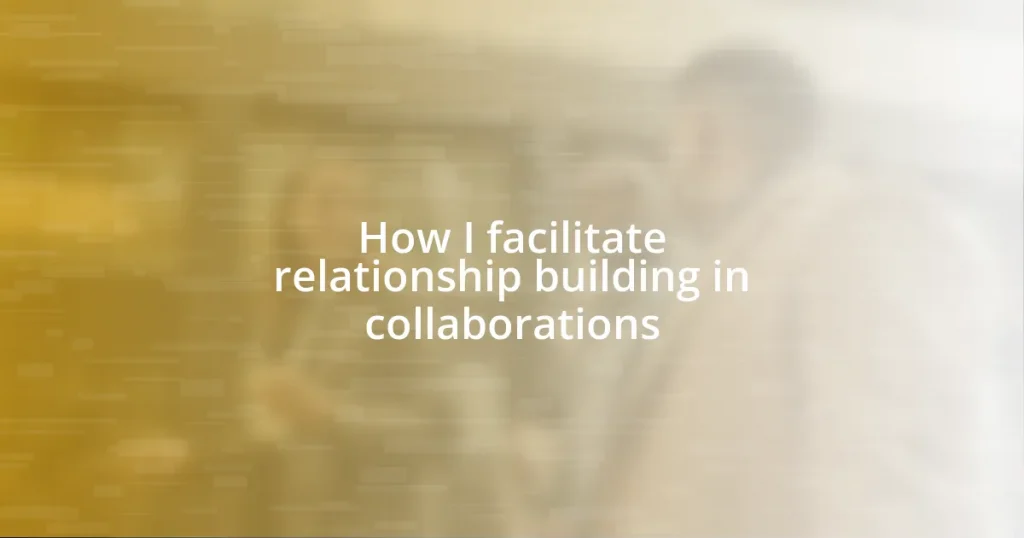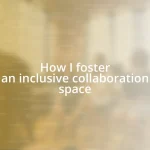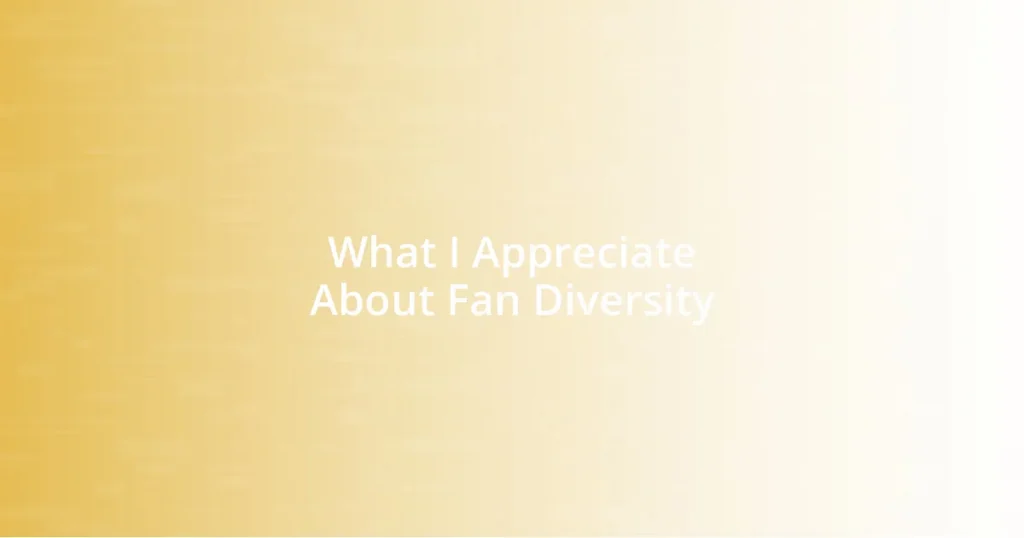Key takeaways:
- Building relationships involves emotional connections and open communication, fostering trust and empathy among team members.
- Setting clear mutual goals using SMART criteria enhances focus and accountability in collaborations.
- Encouraging active participation and recognizing contributions creates a vibrant atmosphere that boosts creativity and engagement.
- Implementing effective conflict resolution strategies, such as active listening and interest-based approaches, can transform tension into collaborative growth.

Understanding relationship building
Building relationships is much more than just networking; it’s about connecting on a deeper level. I recall a project where I worked with a team spread across different time zones. We started with scheduled video calls, but I soon realized that spontaneous, informal chats brought us closer. Isn’t it interesting how opening up about personal interests can make work feel more like teamwork?
The emotional aspect of relationship building is critical. I’ve found that sharing personal challenges or successes fosters empathy and trust. On one occasion, when I mentioned my struggles with balancing professional and personal life, a fellow collaborator shared her story, too. This moment of vulnerability transformed our working relationship, creating a safe space for open dialogue. Have you ever noticed how shared experiences can act as a glue in collaborations?
Listening actively is a powerful tool in building relationships. In my experience, when I genuinely engage with my collaborators’ perspectives, it not only strengthens our connection but also enhances our productivity. I always ask follow-up questions, showing that I value their input. This practice has often led to richer discussions and more innovative solutions. How do you actively listen in your collaborations?

Importance of collaboration trust
Trust is the foundation of effective collaboration. I’ve learned that when team members feel secure with one another, they are more likely to share their ideas and take risks. For instance, during one collaborative project, our team leader encouraged us to voice our suggestions without fear of criticism. This openness led to a breakthrough idea that none of us would have shared otherwise, purely because we felt trusted.
Building trust takes time and consistent effort. I remember a situation where I had a colleague who was hesitant to share her insights early on. After a few team lunches and casual check-ins outside of formal meetings, she slowly opened up, revealing her brilliant ideas. It was a reminder that relationships thrive on shared experiences. In fostering trust, we not only grew closer but also tapped into a wealth of creativity that propelled our project forward.
Without trust, collaboration can feel forced and unproductive. I once participated in a project where trust was lacking, and it hampered our ability to communicate effectively. The result? Delays and misunderstandings. Reflecting on that experience, I realize how critical it is to create an environment where everyone feels safe and valued. Trust empowers openness, encourages risk-taking, and ultimately leads to successful collaborations.
| Aspects of Trust in Collaboration | Effects of Trust |
|---|---|
| Open communication | Encourages idea-sharing |
| Team bonding | Enhances creativity |
| Emotional safety | Reduces fear of failure |
| Reliability | Increases accountability |

Techniques for effective communication
Effective communication is the cornerstone of successful collaborations. I’ve often found that clarity is key; it’s not just about sharing information, but doing so in a way that’s easily understood. During one project, I made it a practice to summarize our discussions at the end of meetings. This not only ensured everyone was on the same page but also provided an opportunity for questions, sparking deeper conversations. The result? A shared understanding that led to more cohesive teamwork.
When it comes to techniques for effective communication, consider these approaches:
- Active Listening: Truly focus on what your collaborators are saying. I’ve discovered that reflecting back what I’ve heard often leads to richer dialogue.
- Open-Ended Questions: These invite deeper responses. Asking, “What are your thoughts on this?” encourages team members to engage and explore ideas.
- Nonverbal Cues: Pay attention to body language. I’ve noticed that sometimes a nod or a smile can convey support and understanding more than words ever could.
- Frequent Check-ins: Regularly gauge the team’s morale and understanding. One quick chat over coffee can clarify uncertainties that email chains can’t address.
- Feedback Loops: Create a system for giving and receiving feedback. I learned the hard way that timely, constructive feedback can prevent lingering doubts from festering and improve team dynamics.
In my experience, these techniques not only enhance communication but foster a spirit of collaboration where everyone feels empowered to contribute. It’s amazing how things shift when each voice is not only heard but valued.

Setting clear mutual goals
Setting clear mutual goals is essential for any successful collaboration. I vividly remember a project where we spent a dedicated session aligning our objectives. We gathered around a whiteboard, and each team member shared their individual goals. It was enlightening to see how our aspirations intertwined, creating a unified vision that energized the whole team. Have you ever experienced that moment when everyone’s enthusiasm converges on a common purpose? It’s not just motivating; it’s like charging a battery together.
In my practice, I’ve learned to use SMART criteria—Specific, Measurable, Achievable, Relevant, and Time-bound—to clarify our goals. While it might sound a bit formal, this approach transforms vague intentions into concrete plans. For instance, instead of saying, “We want to improve our product,” we specified, “We aim to boost user satisfaction by 20% within six months.” This clarity kept us focused and accountable. It’s a simple yet effective strategy that I’ve found keeps the collaboration on track.
Moreover, revisiting these goals regularly fosters accountability and adaptability. During one collaboration, we faced unexpected hurdles that threatened our timeline. By revisiting our goals, we tweaked them, ensuring they remained relevant. This flexibility turned a potential setback into an opportunity for growth. It’s fascinating how our collective understanding of goals can adapt in real-time, reinforcing teamwork in the face of challenges. So, how do you ensure everyone feels equally invested in those goals? That’s where open dialogue and regular touchpoints come into play, amplifying our commitment to success.

Encouraging active participation
Encouraging active participation in collaborations is not just a strategy; it’s a mindset. Whenever I’m leading a brainstorming session, I ensure that everyone has a chance to voice their thoughts. For instance, in one memorable meeting, I encouraged quieter team members to share their ideas first. To my surprise, this approach unlocked a treasure trove of creativity that energized the entire group. Have you ever noticed how some people thrive when they feel their input is genuinely valued? It can transform the atmosphere, making collaboration more vibrant and dynamic.
Creating a safe space for contributions is crucial. I once attended a workshop where the facilitator established ground rules that fostered openness and respect. This simple act empowered participants to express their thoughts without fear of judgment. When I implement a similar approach, I notice that even the most reserved individuals begin to engage passionately. I often ask, “What’s the wildest idea you can think of?” This not only invites innovative thinking but also loosens the grip of self-doubt. I’ve seen how such intentional questioning can lead to unexpected breakthroughs that benefit the entire team.
Another aspect that significantly boosts participation is celebrating contributions, no matter how small. During a recent project, I made it a point to acknowledge individuals for their inputs during team meetings. One team member remarked, “It feels great to be recognized!” This affirmation not only motivated that individual but also encouraged others to speak up. It’s incredible how recognition can spark a sense of belonging, isn’t it? Fostering this kind of environment incentivizes active participation, creating a collaboration where everyone feels they play a vital role.

Conflict resolution strategies
Conflict is a natural part of any collaboration, but having effective resolution strategies can turn tension into growth. I recall a time when two team members disagreed on the approach to a critical project milestone. Instead of letting the disagreement fester, I facilitated a “cool off” session, where we each expressed our perspectives without interruption. It was fascinating to see how, once emotions cooled, they could find common ground that led to a hybrid solution. Have you ever witnessed how simply allowing space for opinions can disarm a tense situation?
One powerful strategy I often lean on is the “interest-based” approach to conflict resolution. This means focusing on underlying interests rather than positions. For example, during a project setback, rather than sticking to who was right or wrong, we discussed what we all wanted to achieve. Each person shared their concerns, and I guided the conversation toward common stakes. I learned that when team members see how their individual needs align with shared goals, it fosters collaboration and understanding.
Active listening also plays a pivotal role in resolving conflicts. I remember a meeting where tensions flared, and it became clear that one team member felt unheard. I encouraged the group to practice reflective listening by summarizing what each person said before responding. This simple shift in our communication style helped clarify misunderstandings and transformed our dynamic. In your experience, how often do you pause to fully listen before jumping to conclusions? I’ve found that fostering this habit can dramatically reduce conflicts and promote a collaborative spirit.

Measuring collaboration success
Measuring collaboration success can sometimes feel elusive, but I’ve found that tracking tangible outcomes can provide clear indicators. For instance, I once implemented a feedback loop within a project team, where we conducted quick, anonymous surveys after major discussions. The results revealed not just satisfaction levels, but also which ideas resonated most with the group. This approach not only sharpened our focus but also made everyone feel that their thoughts were shaping the project’s direction. Have you considered how feedback can empower your collaborative efforts?
In my experience, qualitative metrics are just as important. After completing a significant collaboration, I initiated a reflection session with the team to discuss what we learned, highlighting moments of success and areas for growth. It was revealing to hear different perspectives through this shared dialogue. One member shared that they felt more connected to the team than ever before. These insights reminded me of how the emotional landscape of a project can greatly influence overall success, don’t you think?
Another effective way to measure success is by tracking the longevity and depth of relationships built during the collaboration. I once monitored follow-up interactions outside our primary project after the end of the collaboration. To my delight, many team members continued to support each other’s initiatives. This organic growth spoke volumes about our collaboration’s effectiveness. By considering these relationship dynamics, we can gauge the real impact of our collaborative experiences. Ultimately, it’s about creating a lasting network of support, something we all strive for, isn’t it?















